What is the difference between binlog/redolog/undolog in MySQL?
What is the difference between MySQL binlog/redolog/undolog?
If I want to talk to you about the locking mechanism in InnoDB, it will inevitably involve the MySQL log system, binlog, redo log, undo log, etc. I saw these three logs summarized by some friends. Not bad, hurry up and share it with your friends.
The log is an important part of the mysql database, recording various status information during the operation of the database. mysql Logs mainly include error logs, query logs, slow query logs, transaction logs, and binary logs.
As a developer, what we need to focus on is the binary log (binlog) and transaction log (including redo log and undo log). This article will introduce these three types of logs in detail next.
bin log
binlog is used to record write operations (excluding queries) information performed by the database and is saved on the disk in binary form. binlog is the logical log of mysql and is recorded by the Server layer. The mysql database using any storage engine will record binlogLog.
Logical log: It can be understood that what is recorded is the sql statement.
Physical log:
mysqlThe data is ultimately saved In the data page, the physical log records the data page changes.
binlog is written by appending. Each binlog file can be set through the max_binlog_size parameter. When the file size reaches the given value, a new file will be generated to save the log.
In actual applications, binlog has two main usage scenarios, namely master-slave replication and data recovery.
Master-slave replication: Open
binlogon theMasterside, and then sendbinlogto eachSlaveside,Slaveside replaysbinlogto achieve master-slave data consistency.Data recovery: Recover data by using the
mysqlbinlogtool.
binlog flushing timing
For the InnoDB storage engine, it will only be recorded when the transaction is committedbiglog , the record is still in the memory at this time, so when was biglog flushed to the disk?
mysqlControl the flushing timing of biglog through the sync_binlog parameter, the value range is 0-N:
0: No mandatory requirement, the system will decide when to write to the disk;
1: Every time
commit##binlogmust be written to the disk when #;- N:
binlog
will be written to the disk for every N transactions.
sync_binlog is 1, which is also MySQL 5.7.7Default value for subsequent versions. However, setting a larger value can improve database performance. Therefore, in actual situations, you can also increase the value appropriately and sacrifice a certain degree of consistency to obtain better performance.
binlogThe log has three formats, namely STATMENT, ROW and MIXED.
MySQL 5.7.7, the default format is STATEMENT, after MySQL 5.7.7, the default value is ROW . The log format is specified by binlog-format.
STATMENT
: Replication based onSQLstatements (statement-based replication, SBR), each statement will be modified The SQL statements of the data will be recorded inbinlog.ROW
: Row-based replication (row-based replication, RBR), does not record the context information of each SQL statement, only It is necessary to record which data has been modified.MIXED
: Mixed-based replication based onSTATMENTandROW, MBR), general copying usesSTATEMENTmode to savebinlog, for operations that cannot be copied inSTATEMENTmode, useROWmode Savebinlogredo log
Why do we need redo log
We all know the four major characteristics of transactions One of them is persistence. Specifically, as long as the transaction is submitted successfully, the modifications made to the database will be permanently saved, and it is impossible to return to the original state for any reason.So how does
mysqlensure consistency?
The simple way is to flush all data pages involved in modifications to disk every time a transaction is committed. However, doing so will cause serious performance problems, mainly reflected in two aspects:
Because
Innodbperforms disk interaction in units ofpages, and a transaction is likely to only modify a few data pages. Bytes, it would be a waste of resources to flush the complete data page to the disk at this time!A transaction may involve modifying multiple data pages, and these data pages are not physically continuous. The performance of using random IO writing is too poor!
So
mysqldesignedredo log. Specifically, it only records what modifications the transaction has made to the data page, so It can perfectly solve the performance problem (relatively speaking, the file is smaller and it is sequential IO).
Basic concepts of redo log
redo log includes two parts: one is the log buffer in memory (redo log buffer), The other is the log file on disk (redo logfile).
mysqlEach time a DML statement is executed, the record is first written to redo log buffer, and then at a later point in time, multiple records are written at once. Operation records are written to redo log file. This technology of writing logs first and then writing to disk is the WAL (Write-Ahead Logging) technology often mentioned in
MySQL.
In computer operating systems, buffer data in user space (user space) generally cannot be written directly to the disk, and must pass through the operating system kernel space (kernel space) buffer (OS Buffer).
Therefore, redo log bufferwriting redo logfile actually writes OS Buffer first, and then calls through the system fsync()Flash it to redo log file
, the process is as follows:
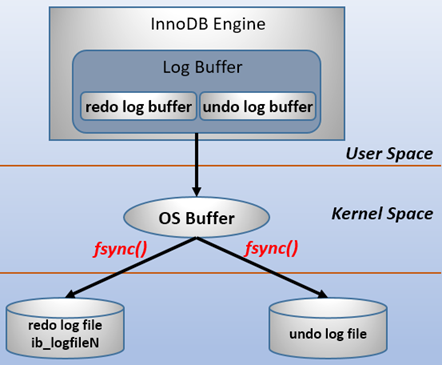
mysqlSupport Three timings for writing redo log buffer to redo log file can be configured through the innodb_flush_log_at_trx_commit parameter. The meaning of each parameter value is as follows:
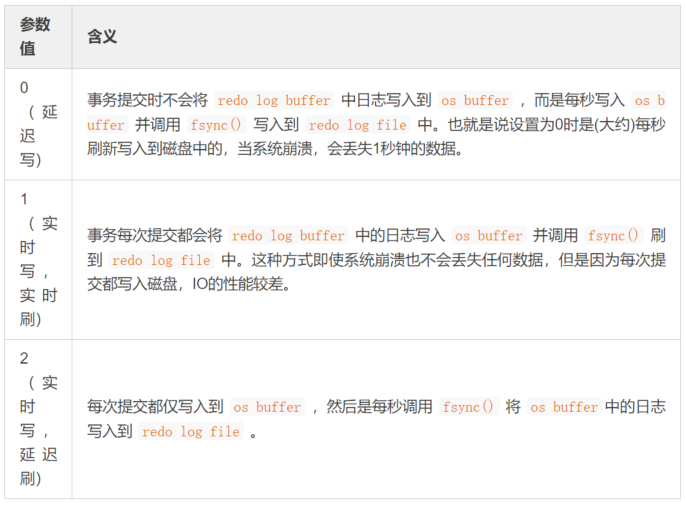
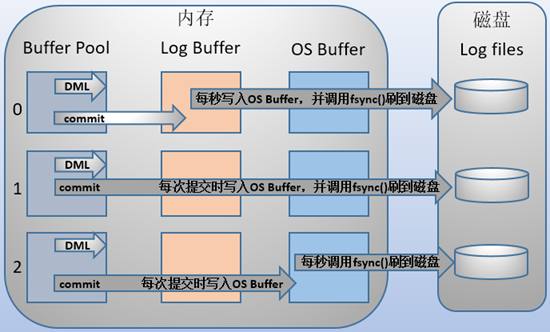
redo log recording format
As mentioned earlier, redo logactually records changes to the data page, and this It is not necessary to save all the change records, so redo log is implemented using a fixed size and cyclic writing method. When writing to the end, it will return to the beginning to write the log in a loop. As shown below:
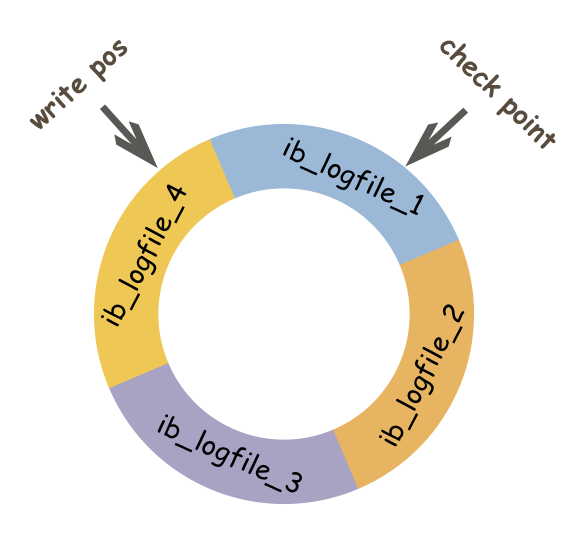
At the same time, we can easily know that in innodb, there are redo log that need to be flushed, and also There are data pages that also need to be flushed. The main significance of redo log is to reduce the requirement for data pages to be flushed**.
In the above figure, write pos represents the LSN (logical sequence number) position of the redo log current record, check point indicates the LSN (logical sequence number) position corresponding to redo log after the data page change record is flushed.
write posThe part between check point is the empty part of redo log, used to record new records;## Between #check point and write pos is the redo log change record of the data page to be written to the disk. When write pos catches up with check point, it will first push check point forward, vacate the position, and then record a new log.
innodb, no matter whether it was shut down normally or abnormally last time, the recovery operation will always be performed. Because redo log records the physical changes of the data page, the recovery speed is much faster than the logical log (such as binlog).
innodb, it will first check the LSN of the data page in the disk. If the LSN of the data page is less than the in the log LSN, the recovery will start from checkpoint.
checkpoint is in progress before the downtime, and the disk brushing progress of the data page exceeds the disk brushing progress of the log page. At this time, data will appear. The LSN recorded in the page is greater than the LSN in the log. At this time, the part that exceeds the progress of the log will not be redone, because this itself means that what has been done does not need to be redone. Do.
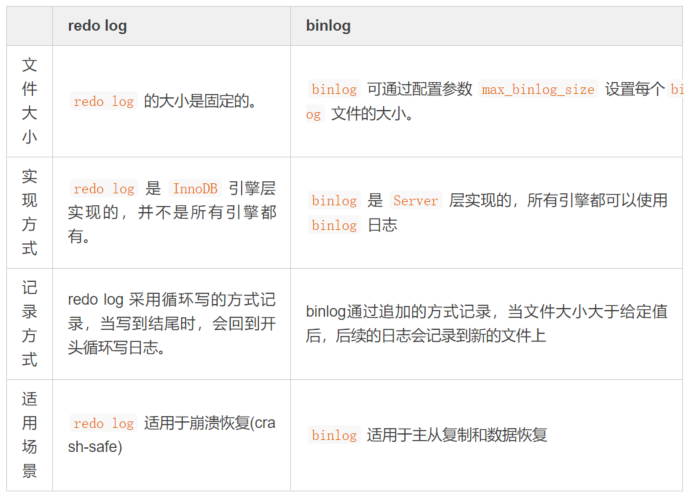
binlog and redo log: The binlog log is only used for archiving, and relying solely on binlog does not have the crash-safe capability.
But only redo log will not work, because redo log is unique to InnoDB, and the records in the log will be overwritten after being written to disk. Therefore, both binlog and redo log need to be recorded at the same time to ensure that when the database is down and restarted, the data will not be lost.
undo log
One of the four major characteristics of database transactions is atomicity. Specifically, atomicity refers to a series of operations on the database, either all succeed or all fail. There may be partial success.
In fact, the bottom layer of atomicity is achieved through undo log. undo log mainly records the logical changes of data. For example, an INSERT statement corresponds to a undo log of DELETE, for each # The ##UPDATE statement corresponds to an opposite UPDATE's undo log, so that when an error occurs, you can roll back to the data state before the transaction.
undo log is also the key to MVCC (multi-version concurrency control) implementation.
The above is the detailed content of What is the difference between binlog/redolog/undolog in MySQL?. For more information, please follow other related articles on the PHP Chinese website!

Hot AI Tools

Undresser.AI Undress
AI-powered app for creating realistic nude photos

AI Clothes Remover
Online AI tool for removing clothes from photos.

Undress AI Tool
Undress images for free

Clothoff.io
AI clothes remover

Video Face Swap
Swap faces in any video effortlessly with our completely free AI face swap tool!

Hot Article

Hot Tools

Notepad++7.3.1
Easy-to-use and free code editor

SublimeText3 Chinese version
Chinese version, very easy to use

Zend Studio 13.0.1
Powerful PHP integrated development environment

Dreamweaver CS6
Visual web development tools

SublimeText3 Mac version
God-level code editing software (SublimeText3)

Hot Topics
 MySQL's Role: Databases in Web Applications
Apr 17, 2025 am 12:23 AM
MySQL's Role: Databases in Web Applications
Apr 17, 2025 am 12:23 AM
The main role of MySQL in web applications is to store and manage data. 1.MySQL efficiently processes user information, product catalogs, transaction records and other data. 2. Through SQL query, developers can extract information from the database to generate dynamic content. 3.MySQL works based on the client-server model to ensure acceptable query speed.
 Laravel Introduction Example
Apr 18, 2025 pm 12:45 PM
Laravel Introduction Example
Apr 18, 2025 pm 12:45 PM
Laravel is a PHP framework for easy building of web applications. It provides a range of powerful features including: Installation: Install the Laravel CLI globally with Composer and create applications in the project directory. Routing: Define the relationship between the URL and the handler in routes/web.php. View: Create a view in resources/views to render the application's interface. Database Integration: Provides out-of-the-box integration with databases such as MySQL and uses migration to create and modify tables. Model and Controller: The model represents the database entity and the controller processes HTTP requests.
 How to start mysql by docker
Apr 15, 2025 pm 12:09 PM
How to start mysql by docker
Apr 15, 2025 pm 12:09 PM
The process of starting MySQL in Docker consists of the following steps: Pull the MySQL image to create and start the container, set the root user password, and map the port verification connection Create the database and the user grants all permissions to the database
 Solve database connection problem: a practical case of using minii/db library
Apr 18, 2025 am 07:09 AM
Solve database connection problem: a practical case of using minii/db library
Apr 18, 2025 am 07:09 AM
I encountered a tricky problem when developing a small application: the need to quickly integrate a lightweight database operation library. After trying multiple libraries, I found that they either have too much functionality or are not very compatible. Eventually, I found minii/db, a simplified version based on Yii2 that solved my problem perfectly.
 How to install mysql in centos7
Apr 14, 2025 pm 08:30 PM
How to install mysql in centos7
Apr 14, 2025 pm 08:30 PM
The key to installing MySQL elegantly is to add the official MySQL repository. The specific steps are as follows: Download the MySQL official GPG key to prevent phishing attacks. Add MySQL repository file: rpm -Uvh https://dev.mysql.com/get/mysql80-community-release-el7-3.noarch.rpm Update yum repository cache: yum update installation MySQL: yum install mysql-server startup MySQL service: systemctl start mysqld set up booting
 Centos install mysql
Apr 14, 2025 pm 08:09 PM
Centos install mysql
Apr 14, 2025 pm 08:09 PM
Installing MySQL on CentOS involves the following steps: Adding the appropriate MySQL yum source. Execute the yum install mysql-server command to install the MySQL server. Use the mysql_secure_installation command to make security settings, such as setting the root user password. Customize the MySQL configuration file as needed. Tune MySQL parameters and optimize databases for performance.
 Laravel framework installation method
Apr 18, 2025 pm 12:54 PM
Laravel framework installation method
Apr 18, 2025 pm 12:54 PM
Article summary: This article provides detailed step-by-step instructions to guide readers on how to easily install the Laravel framework. Laravel is a powerful PHP framework that speeds up the development process of web applications. This tutorial covers the installation process from system requirements to configuring databases and setting up routing. By following these steps, readers can quickly and efficiently lay a solid foundation for their Laravel project.
 MySQL and phpMyAdmin: Core Features and Functions
Apr 22, 2025 am 12:12 AM
MySQL and phpMyAdmin: Core Features and Functions
Apr 22, 2025 am 12:12 AM
MySQL and phpMyAdmin are powerful database management tools. 1) MySQL is used to create databases and tables, and to execute DML and SQL queries. 2) phpMyAdmin provides an intuitive interface for database management, table structure management, data operations and user permission management.






